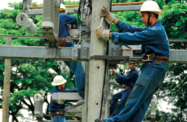Large-scale commitments by the Philippine government will increase sustainable power’s already significant contribution to the energy mix.

In early March the Board of Investments (BoI), the investment promotion agency, revealed details of eight solar projects worth P86bn ($1.7bn) to be rolled out from October.
The largest, the Iba-Palauig 2 Solar Project, is a P19bn ($365.9m) photovoltaic power plant for the Zambales region. The facility will have a peak generation capacity of 140 MW and is scheduled to begin operations in February 2020.
A second project for two facilities in Cavite Province – Maragondon-Naic 1 and Marangondon-Naic Tanza 2 – is valued at P17.3bn ($330.2m) and is expected to be operational from October this year, providing a combined capacity of 392 MW, while two projects worth P13.6bn ($261.9m) each for solar farms in Tarlac and Batangas, expected to come on-line by January 2019 and February 2020, respectively, will have a combined 588-MW capacity. Another facility slated to become operational in early 2020 in Nueva Ecijia will add 194 MW.
Capacity specifications for the final two projects, to be deployed in the Tarlac region, have yet to be announced.
The projects are contracted to solar farm and panel developer Solar Philippines Commercial Rooftop Projects and, as projects that aim to reduce greenhouse emissions, qualify for incentives under the government’s Investments Priorities Plan.
Of 29 new energy investments approved by the Department of Energy (DoE) in late January, 15 were focused on renewables. Alongside the eight solar projects, there were three biomass and five hydropower developments. Fossil fuel projects made up the remainder, the largest being a 1000-MW, coal-fired plant in Quezon. Total investments signed in January represent a 541% increase over the previous year, according to the BoI.
Long-term renewable development plans
The Philippines is already a regional leader for generating power from clean energy; renewables account for 24.2% of gross generation and 32.5% of installed capacity, representing just over 7000 MW, according to the Institute of Climate and Sustainable Cities.
As the technology becomes increasingly affordable and contracts for renewable projects, particularly solar, become more competitive, this share is expected to increase in line with the DoE’s energy security targets, which involve boosting generation capacity to 25% above peak demand.
In the longer term, the DoE estimates the Philippines will need to deploy an additional 44,800 MW of new capacity between now and 2040. This addition, of which the newly approved projects are just a small part, would more than double existing installed capacity, which stood at 21,600 MW in the second half of 2017. Of the total, the DoE expects renewables to account for a minimum of 20,000 MW. The government is also looking to broaden its energy mix to potentially include nuclear in the future.
Proposed tax changes could affect energy investments
The role renewables play in the future energy mix could be affected if future projects become less cost competitive as a result of proposed changes to the tax regime.
In a presentation to energy industry stakeholders in March, the Department of Finance said it was considering removing the zero-rated, value-added tax currently in place for the renewables industry.
According to local press reports, the move is part wider energy reforms that could see the removal of around P11.2bn ($22.9m) worth of tax and import duty incentives for energy investments under the government’s Tax Reform for Acceleration and Inclusion (TRAIN) initiative, which aims to generate revenue for health, social care and infrastructure development.
This has raised concerns among developers, who in a letter to Congress said the incentive “is a necessary component of the fiscal incentives package enabling the renewables industry to provide clean, sustainable and lower-cost electricity to end-consumers”.
However, the challenge posed by the potential change could be partially offset by higher levies on coal imposed under the first package of TRAIN reforms introduced last December.
In addition to lowering personal income taxes and raising duties on fuel, cars and some consumer goods, TRAIN 1 increased excise duties on coal imports from P10 ($0.19) per tonne to P50 ($0.95), and this is expected to triple to P150 ($2.85) per tonne by 2020.
The government is also considering imposing higher tariffs on the local coal industry, which has benefitted from excise tax exemptions since the 1980s.
The tax hikes are expected to lead to price increases for electricity, as power plants fuelled by coal account for around 48% of power supply.


